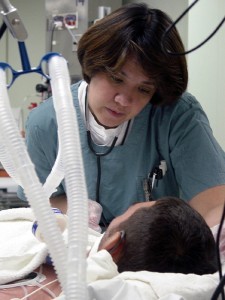Critical Care Nursing – High Risk Practice
 Critical care nurses take care of some of our sickest patients. They practice in a high risk environment – both clinically and in terms of litigation. We take critical care nursing for granted, but they were not always among us. Critical care nursing in the United States began with the recognition that specialty nursing was necessary to more adequately care for seriously ill patients with complex needs. Ongoing technological advancements in diagnostics and treatment of the critically ill led to the emergence of specialty intensive care units, the first being a coronary care unit at Abington Memorial Hospital outside Philadelphia.
Critical care nurses take care of some of our sickest patients. They practice in a high risk environment – both clinically and in terms of litigation. We take critical care nursing for granted, but they were not always among us. Critical care nursing in the United States began with the recognition that specialty nursing was necessary to more adequately care for seriously ill patients with complex needs. Ongoing technological advancements in diagnostics and treatment of the critically ill led to the emergence of specialty intensive care units, the first being a coronary care unit at Abington Memorial Hospital outside Philadelphia.
Why we got critical care nursing units
The modern-day Intensive Care Unit (ICU) developed because of three major forces:
1. the recognition of the need for grouping patients according to special needs encourages specialty nursing and concentrates expensive equipment;
2. complex technology and medical procedures demand more extensive and specialized observation in one location; and
3. ICUs relieve recovery rooms or post-anesthesia care units (PACUs) from pressure to extend the patient stay from hours to days.
What is Critical Care Nursing?
The American Association of Critical Care Nurses (AACN), born out of this need for knowledge, continues to be a major force in providing educational support, as well as certification opportunities for the critical care nurse. Many definitions have been used to describe critical care nursing, but the AACN defines it as “the specialty of nursing that deals with human responses to life-threatening problems.” It is a specialty that is practiced in a setting where direct observation, monitoring, and rapid intervention are possible.
Today, we are in the middle of a revolution permanently altering how health care is delivered and how its quality is assessed. An emphasis placed on primary, preventive, and holistic care, and the rise of managed care have substantially altered the roles and philosophies of multiple healthcare providers, especially critical care nurses. Patients are often admitted to hospitals because they need intensive nursing care. Nurses have become primary care providers in some instances. These recent changes in the healthcare environment have led to greater identification and reliance on knowledge, expertise, and services of all healthcare providers, but especially the critical care nurse.

Expanding role of critical care nurses
Critical care nurses no longer focus only on the patient’s acute illness event. In the rapidly changing healthcare environment, critical care nurses must expand their care to include education on prevention and risk factor modification to decrease future patient admissions to acute care facilities.
As legal nurse consultants, we know that professional accountability must be maintained through adherence to standards of nursing care of the critically ill and through a commitment to act in accordance with ethical principles. Certification and special skills are needed to perform Advanced Cardiac Life Support (ACLS). Continuing education is necessary for critical care nurses to be knowledgeable and proficient about emergency cardiovascular care.
The nurse is the key person in the intensive care or critical care unit (CCU), with the potential to directly influence patient outcomes.
Dependent, Independent and Interdependent Nursing
Critical care nurses do not practice in isolation but rather in concert with other healthcare providers. Through exchange of ideas and demonstration of clinical expertise, each practitioner is able to evaluate professional competence. Trust can then be established and new collaborative roles for all healthcare providers in the critical care environment become possible. Areas of nursing activities are dependent, independent, and interdependent, as outlined in the AACN standards of care.
- Orders and medical care plans, defined as those directed primarily by physicians, are dependent nursing interventions.
- Independent nursing interventions are unique to nursing, assessment, diagnosis, teaching, counseling, and manipulation of the patient’s environment.
- Today’s ICU environment reveals increasingly interdependent activities of shared interest, such as quality improvement and mutual responsibility for unit operation, organization, and administration.
Professional obligations and responsibilities become clearer when dependent, independent, and interdependent areas of activity are considered. Critical care nurses must accept professional, ethical, and legal responsibility for their actions and, to some extent, the actions of the entire healthcare team.
Modified from Kathleen Ashton and Jenny Beerman, Critical Care Malpractice Issues, in Iyer, Levin, Ashton and Powell, Nursing Malpractice, Fourth edition. Grab your copy.
